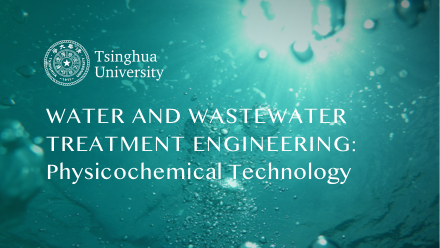
当前课程知识点:Water and Wastewater Treatment Engineering: Physicochemical Technology > Chapter 1 Coagulation and flocculation > 1-6 Factors affecting the coagulation performance > 1-6 Factors affecting the coagulation performance
返回《Water and Wastewater Treatment Engineering: Physicochemical Technology》慕课在线视频课程列表
返回《Water and Wastewater Treatment Engineering: Physicochemical Technology》慕课在线视频列表
同学们好,今天我们继续介绍第二章混凝
在今天这一讲里,我们介绍第6节混凝效果的主要影响因素
影响混凝效果的因素比较复杂
包括水温,水的化学特性,比如pH值和碱度
另外水中杂质的性质和浓度也会对混凝效果产生影响
首先是水温的影响
在我国不少地区冬季地表水水温很低,导致水的混凝效果不佳
水温低时混凝效果差的主要原因可能有以下几个方面
第一如果我们采用无机盐混凝剂
其水解是吸热反应,因此低温时混凝剂水解困难
第二低温时水的黏度大,导致水中杂质颗粒布朗运动强度减弱
碰撞机会减少,因此不利于胶体的脱稳与凝聚
第三水温低时,胶体颗粒的水化作用增强,妨碍胶体发生凝聚
因此,低温水的混凝是水处理中的一个难题
为了提高低温水的混凝效果
我们可以采用增加混凝剂投加量、添加高分子助凝剂来提高混凝效果
同时我们也可以采用其他固液分离方法,比如气浮等
来代替沉淀作为混凝的后续处理工艺单元
以避免低温混凝形成的絮凝体不够密实和不够大时,导致沉淀效果降低
第二是水的pH值和碱度的影响
水的pH值对混凝效果的影响,主要与混凝剂的种类有关
对于无机盐类混凝剂,水的pH值直接影响无机盐的水解和聚合反应
从而影响水解产物的存在形态,因此影响混凝效果
但如果我们采用的是高分子混凝剂,其混凝效果受水的pH值影响就比较小
对于无机盐类混凝剂的水解,由于会不断产生H+,就会导致pH值降低
而要使pH值保持在最佳范围
水中就应该有足够的碱性物质,比如氢氧根、碳酸氢根等,来与水的H+进行中和
当水中碱度不足或混凝剂投加量比较高时
就应该投加碱剂(如石灰)来中和混凝剂水解过程中产生的H+
这里我们以硫酸铝为例来进行介绍,反应方程如这个式子所示
石灰的投加量可以通过这个公式进行计算
这里a代表混凝剂投量,x代表原水碱度
δ为保证反应顺利进行所需要的剩余碱度,一般取0.25-0.5 mmol/L
但是应当注意,石灰的投加不可过量
否则形成的氢氧化铝沉淀就会溶解,使混凝效果恶化
第三是水中杂质的性质和浓度的影响
如果水中含有二价以上的正离子时,对天然水中粘土颗粒的双电层压缩有利
因此,有利于提高混凝效果
当水中含有大量有机物时,有机物就会对胶体产生保护作用
混凝效果就会降低,因此需要投加更多的混凝剂才能产生好的混凝效果
而当水中杂质颗粒浓度过低,不利于颗粒间发生碰撞从而影响混凝效果
因此低浊水混凝效果不佳
为了提高低浊水的混凝效果
我们可以通过投加高分子助凝剂、粘土等矿物颗粒来提升低浊水的混凝效果
另外也可以在投加混凝剂后直接过滤
如果原水的浊度和水温都比较低,这就是我们常说的"低温低浊"水的情况
混凝就更加困难
低温低浊水的混凝一直是人们关注的难题
对于我们上述谈到的混凝效果的主要影响因素,通常可以采用混凝实验进行评判
在混凝实验中,通常采用的是6联搅拌机
我们采用的6联搅拌机的装置如图所示,由6个烧杯及搅拌器组成
用这个简单的6联搅拌机,我们就可以开展一系列混凝实验
比如我们可以针对某一原水,来确定某种混凝剂的最佳投加量
也可以研究混凝效果的影响因素,比如前面讲到的pH值、水中杂质等的影响
也可以选择各类混凝剂来比较不同混凝剂的混凝效果
再有我们也可以研究添加高分子助凝剂对混凝效果的影响
这是学生进行混凝实验的现场,大家可以看到,原水在投加混凝剂后
随着搅拌时间的延长,水中就会逐渐形成絮凝体
这些絮凝体就是我们在混凝工艺中常说的矾花
当矾花长到足够大时,如果停止搅拌,让水静置沉淀一段时间后,矾花就会沉淀下来
我们就可以得到清洁的处理水
这个实验是考察投加高分子助凝剂对混凝效果的影响
从左到右是高分子助凝剂投加量由低到高
大家可以看到随着高分子助凝剂投加量的增加,矾花的密实程度会增大
也就是说对混凝效果产生了促进作用
但当高分子助凝剂投加过量时,大家可以从最右边图片看到,水又变混浊了
这就是前面谈到的高分子助凝剂投加过量反而会对胶体形成保护、使胶体再稳的现象
因此高分子助凝剂的投加量需要控制在一个合理的范围
今天关于混凝主要影响因素的内容就介绍到这儿,谢谢
-0-2 Water treatment process
-0-3 Wastewater treatment process
--0-3 Wastewater treatment process
-Chap 0 Homeworks
-1-1 Introduction
-1-2 Properties of colloids
-1-3 Mechanisms and process of coagulation and flocculation
--1-3 Mechanisms of coagulation and flocculation
-1-4 Coagulant and coagulant aids
-- 1-4 Coagulant and coagulant aids
-1-5 Kinetics of coagulation and flocculation
--1-5 Kinetics of coagulation and flocculation
-1-6 Factors affecting the coagulation performance
--1-6 Factors affecting the coagulation performance
-1-7 Facilities for coagulation and flocculation
--1-7 Facilities for coagulation and flocculation
-Chapter 1 Homeworks
-2-1 Introduction
-2-2 Discrete particle settling
--2-2 Discrete particle settling
-2-3 Flocculent settling
-2-4 Zone settling
-2-5 Rectangular settling tank
--2-5 Rectangular settling tanks
-2-6 Process calculation of rectangular settling tanks
--2-6 Process calculation of rectangular settling tanks
-2-7 Vertical Flow (up-flow ) and radial flow settling tank
--2-7 Vertical Flow (up-flow ) and radial flow settling tank
-2-8 Plated sedimentation tank
--2-8 Plated sedimentation tank
-2-9 Clarification pool
-3D interactive demonstration for settling tanks
-Chapter 2 Homework (part 1)
-Chapter 2 Homework (part 2)
-3-1 Introduction
-3-2 Theoretical foundation of air floatation
--3-2 Theoretical foundation of air floatation
-3-3 Pressurized dissolved air flotation
--3-3 Pressurized dissolved air flotation
-Chapter 3 Homework
-4-1 Introduction
-4-2 Structure and process of conventional rapid filter
--4-2 Structure and process of conventional rapid filter
-4-3 Water head loss of filter
--4-3 Water head loss of filter
-4-4 Filtration method of filter
--4-4 Filtration method of filter
-4-5 Filter media
-4-6 Water distribution system
--4-6 Water distribution system
-4-7 Filter backwashing
-4-8 Siphon filter
-4-9 Gravity valveless filter
--4-9 Gravity valveless filter
-4-10 Movable hood filter
-3D interactive demonstration for filtration tanks
--Usage and description for 3-D demonstration
-Chapter 4 Homework
-5-1 Introduction
-5-2 Influence factors of disinfection
--5-2 Influence factors of disinfection
-5-3 Chlorine disinfection
-5-4 Chlorine dioxide disinfection
--5-4 Chlorine dioxide disinfection
-5-5 Ultraviolet disinfection
--5-5 Ultraviolet disinfection
-Chapter 5 Homework
-6-1 Ion-exchange resin
-6-2 Properties of ion-exchange reactions
--6-2 Properties of ion-exchange reactions
-6-3 Properties of cation exchange resin
--6-3 Properties of cation exchange resin
-6-4 Properties of anion exchange resin
--6-4 Properties of anion exchange resin
-6-5 Softening system using ion exchange
--6-5 Softening system using ion exchange
-6-6 Desalination system using ion exchange
--6-6 Desalination system using ion exchange
-6-7 Ion-exchange equipment
-6-8 Treatment of industrial wastewater by ion-exchange method
--6-8 Treatment of industrial wastewater by ion-exchange method
-Chapter 6 Homework
-7-1 Introduction
-7-2 Principle and characteristics of electrodialysis
--7-2 Principle and characteristics of electrodialysis
-7-3 Configuration of electrodialysis unit
--7-3 Configuration of electrodialysis unit
-7-4 Operating parameters for electrodialysis unit
--7-4 Operating parameters for electrodialysis unit
-7-5 Principle and process of reverse osmosis
--7-5 Principle and process of reverse osmosis
-7-6 Operating parameters for reverse osmosis
--7-6 Operating parameters for reverse osmosis
-7-7 Principles and characteristics of UF and MF
--7-7 Principles and characteristics of UF and MF
-7-8 Design of ultrafiltration and microfiltration process
--7-8 Design of ultrafiltration and microfiltration process
-Chapter 7 Homework
-8-1 Fundamental knowledge and classification
--8-1 Fundamental knowledge and classification
-8-2 Ozonation
-8-3 Photo-catalytic oxidation
--8-3 Photo-catalytic oxidation
-8-4 Supercritical water oxidation
--8-4 Supercritical water oxidation
-8-5 Electrolysis
-Chapter 8 Homework
-9-1 Introduction
-9-2 Adsorption equilibrium and adsorption isotherm
--9-2 Adsorption equilibrium and adsorption isotherm
-9-3 Adsorption breakthrough curve
--9-3 Adsorption breakthrough curve
-Chapter 9 Homework


